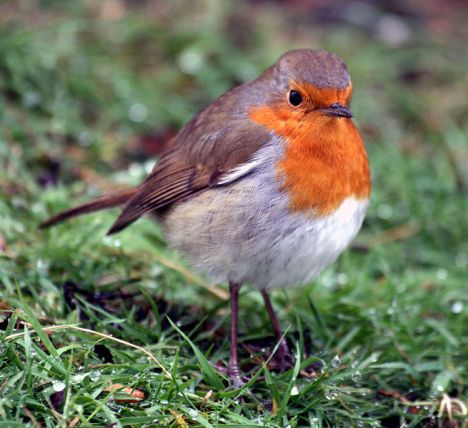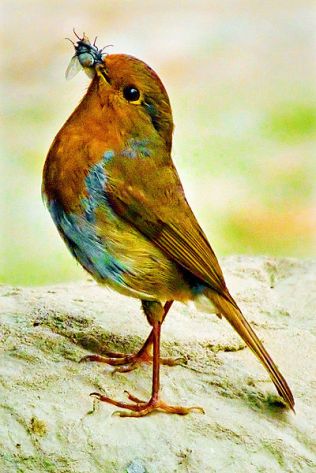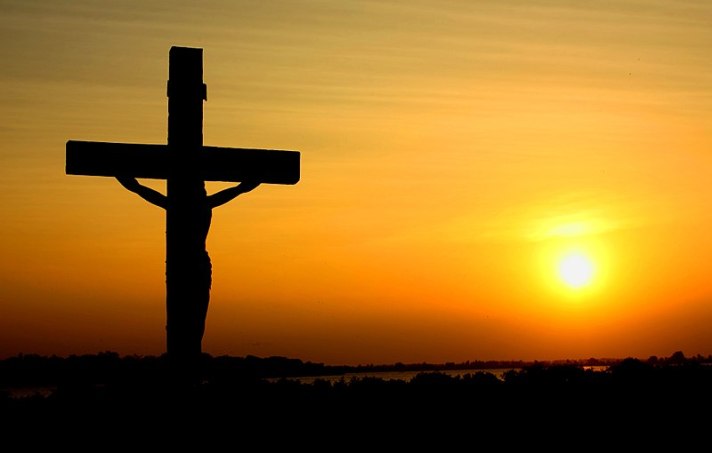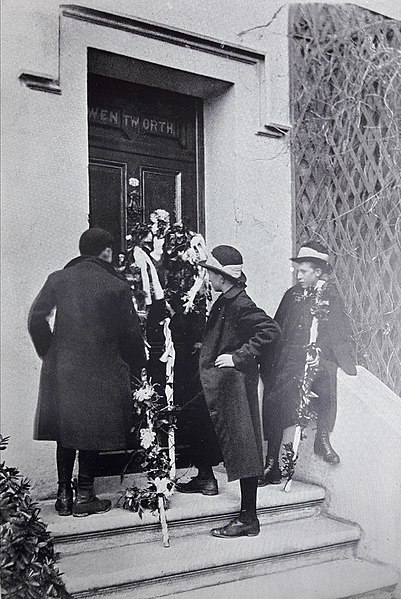Myth Monday: The Robin Redbreast (Christian Legend)
By Kara Newcastle

Groundhogs, feh. You can’t trust those little bucktoothed liars. They pop out of their holes once a year, squint their eyes, then make a prediction on the arrival of spring just by looking at their shadows.
For me, I know that spring is on its way when I start seeing robins scurrying around. They’re the real indicators. They vanish during the winter, but always return when the weather begins to warm. Seeing those flame-red feathers lets me know that however crappy the weather has been—and trust me, it’s been crappy—spring will be here in time.
The robin has been a source of hope and comfort for thousands of years, particularly amongst Christian Europeans in the early days of the church. The robin redbreast was especially sacred and its “wife,” the wren, were considered to be God’s “cock and hen,” the favorite of all His birds. The robin was especially beloved by gardeners, as the bright little birds would clear the plants of pests.

The robin has a plethora of stories explaining where its pretty red feathers came from. Early stories recount how the sympathetic robin was singed by the flames of Hell as it carried water down to the depths either for the burning sinners to drink, or to try to put out the fires. Another variation says that it was the wren who brought water to the damned souls, but when she returned her feathers were on fire. The robin moved quickly, beating his wings to snuff out the fire, only to have his own breast scorched.
Robins are frequently associated with Christmas, not just because of the merry red feathers, but also because a story told of how on the night that Jesus was born, the stable was bitterly cold, and Mary and Joseph struggled to keep a fire lit. Seeing their plight, a then-uncolored robin flew down from the rafters and fanned the flames of their fire as the holy family slept. Mary awoke and was so grateful for the little bird’s kindness that she awarded the robin its red feathers in remembrance, though other stories say it was because the poor bird was slightly burned in its efforts. (A similar story is found in some Native American myths, where an American robin was burned red while fanning the flames of a fire to keep a sleeping man and his son alive through a freezing night.)
If there’s any holiday the robin is most associated with, it’s Easter, and not just because it’s a springtime festival. In Christian European lore, the birds of the earth were horrified as they watched Jesus being nailed to the cross on Golgotha. The robin, swallow and goldfinch lit upon the cross and nearby trees and sang their most beautiful songs, hoping to alleviate his suffering, while the dove, overcome with emotion, could only mourn, and the cruel magpie refused to raise its voice. Seeing Christ in pain tormented the birds, and they fluttered about his head, pulling out the thorns of the crown the Romans had placed upon him. As the robin and swallow pulled the thorns free and a crossbill tried to pry loose the nails, they were splattered with Jesus’s blood, staining their feathers red forever. The robin was also said to burst out in song when it saw the resurrected Christ emerge from the tomb he had been placed in.

Because of the robin’s compassion and its friendly nature, as well as being blessed with the blood of Christ, it was considered to be extremely bad luck to hurt or kill a robin, cage it, disturb its nest or damage its eggs. Anyone who was coldhearted enough to harm the robin would find that the hand they used against the bird would develop an uncontrollable tremor or a tumor or other disfigurement that would make it impossible to work. The Welsh believed that the offender would also suffer the same injury they caused the bird (like a broken leg for a broken leg), and in Scotland, England and German, the robin’s killer would discover that their cows would now produce nothing but bloody milk. The fiend that stole or broke the robin’s eggs may have their most treasured possession destroyed, their child will grow up with ruined pinkie fingers, the thief’s hand might fall off, or their house might be struck by lightning in retaliation. The divine protection that hovered over the robin was enough that it was said even cats wouldn’t attempt to hunt them.
Makes you think twice about shooing robins away from your car, huh?
Furthermore, it was also believed that because it witnessed Jesus’s death on the cross, the robin was linked with death. It was said that robins and wrens couldn’t stand the sight of an unburied corpse and would cover it with leaves and moss, as told in the Babes in the Woods tale. The link between the robins and death might have come from witnessing robins perched in the trees as people dug graves. The people thought the birds were attracted to death, but more likely than not the robins were more interested in the worms the diggers were tossing out of the grave by the shovelful.

Of course, people were extremely superstitious at the time and not keen on critical thinking, so a new crop of tales arose about the robin, such that if it flew into a house or into a church that was filled with parishioners, or sang close by to a person, then someone would soon die. Seeing a robin at the entrance to the mine was thought to portend doom (red has always been considered unlucky by miners, so that doesn’t help the robin any), and if a robin tapped at the bedroom window of a sick person, that person would soon die. At the same time, it was thought that if you saw a robin shortly after a loved one had passed away, that meant the spirit of that person was visiting you, leading to the proverb, “When robins appear, loved ones are near,” making the robin a benevolent messenger of the spirit world.
All the same, people were so unnerved by the robin-death connection that they wouldn’t send get-well cards with robins on them. And Etsy and Zazzle designs notwithstanding, you still don’t see robins on get-well cards today.
On the other hand, the Victorians with their incredible ability to flip ideas around and make the morbid fascinating, loved to send pictures of dead robins and wrens as—of all things—Christmas cards! Why they would do this—why the Victorians did half of all the bizarre crap they did—isn’t entirely known, but it’s either related to the thought that the delicate bird represents the frailty and fleetingness of life, or it harkens further back to ancient and medieval times when robins and wrens were sacrificed at the winter solstice and later evolved into a revived-pagan/Christian ritual celebrated on December 26th (St. Stephen’s Day) in the British Isles. On that day boys in the village (particularly in Ireland, though it was seen in England as well) would hunt down a wren, the symbol of winter, kill it, and say it was slain by the robin, a symbol of spring.

There was also a belief that if you caught a rare sighting of a robin on New Year’s Day, you could make a wish and it would come true. But be quick! If it flies away before you finish your wish, you’ll have nothing but bad luck year-round. Personally, I’d rather not take the chance.
It sounds like encountering a robin may be a mixed-bag of blessings, let me just add a few more facts on the “lucky” side of things; it was said that if a girl saw a robin on Valentine’s Day, she would marry a sailor (haven’t figured out the link to that one yet,) and if a bride saw a robin on the way to the church, or if she and her husband saw one after leaving the church, they were sure to have a happy marriage. If you have a robin following you around your garden, rest assured, you’re safe from menacing fairies; fairies can shapeshift into almost anything except the robin and are petrified of it, so they’ll stay far from your home if robins are about.
Finally, robin redbreasts were also thought to be able to predict the weather. A rhyme from Sussex, England, went as thus:
If the robin sings in the bush,
Then the weather will be coarse
But if the robin sings on the barn,
Then the weather will be warm.
For a tiny bird so steeped in Christian belief, this particular one is actually derived from Viking mythology. The Vikings believed that the robin was sacred to Thor, the god of thunder, and even called it the storm-cloud bird. Robins and other birds are known to leave an area before a bad storm and can be heard singing happily at the end of a rainstorm, which is why our non-meteorologically-inclined forebearers thought that the robin had a link with Thor.
Wow … that’s a lot of folklore for one bitty bird!